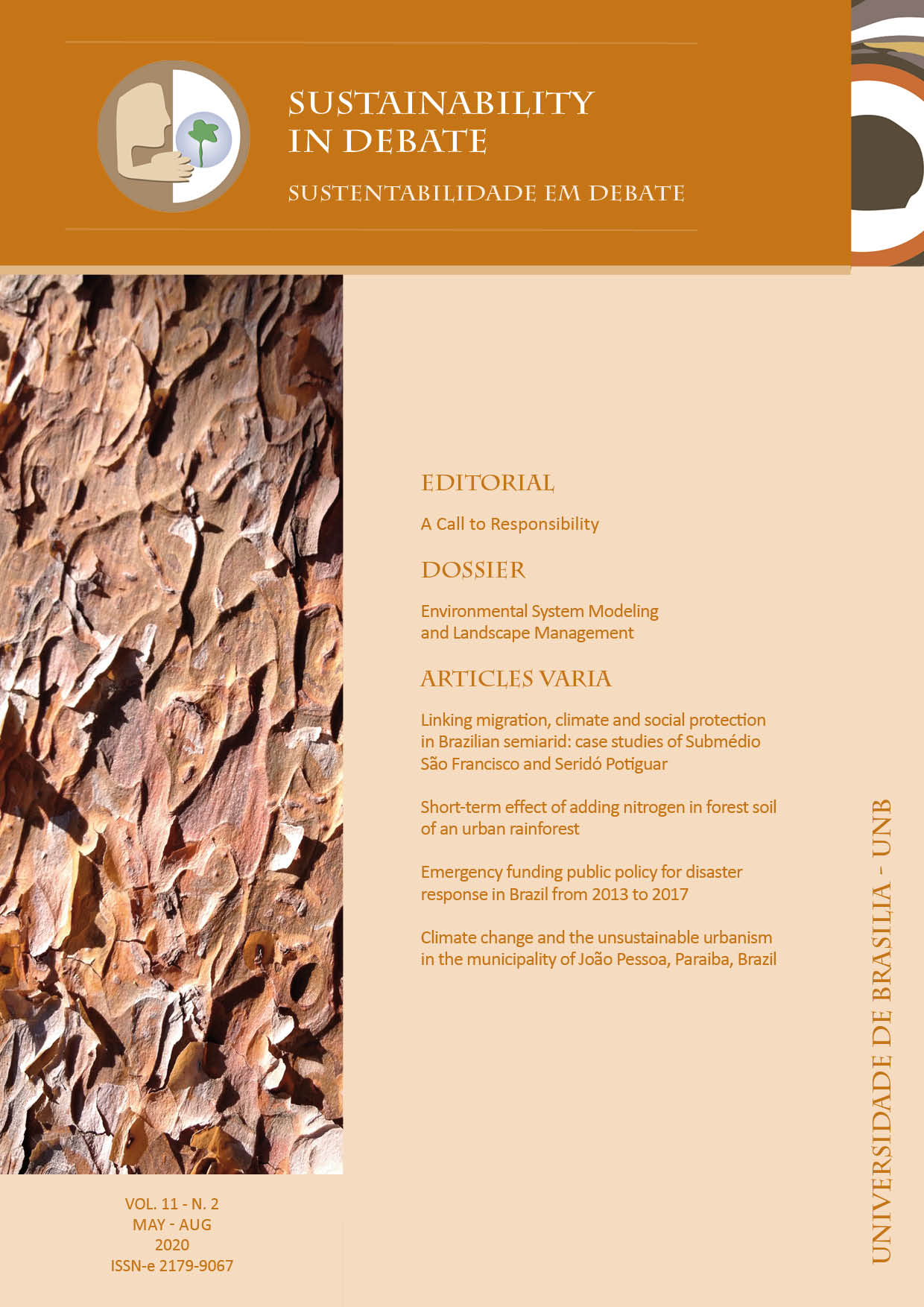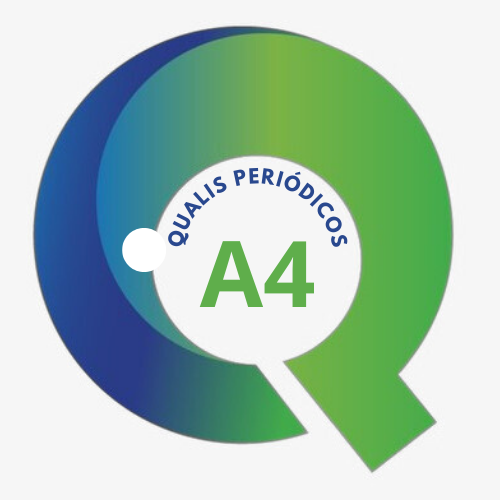The handwriting of society on the landscape: modeling of the Environmental Changes on the Borders of Protected Areas located in the Espinhaço Mountain Range, state of Minas Gerais, Brazil
DOI :
https://doi.org/10.18472/SustDeb.v11n2.2020.2839Résumé
Este artigo analisa os contextos da criação de duas áreas protegidas localizadas na Serra do Espinhaço, no estado de Minas Gerais (Brasil): Parque Estadual do Rio Preto e Parque Estadual de Serra Negra. O trabalho compara os contextos sociais e naturais do processo de criação das duas áreas protegidas entre os anos de 1986 e 2009. Para tanto, buscamos entender os padrões de uso dos recursos naturais pelas populações locais, relacionando-os com os resultados da dinâmica do uso da terra ao longo do tempo, identificados através do monitoramento com imagens orbitais e através da modelagem ambiental. Quanto à análise do uso do solo, as mudanças na paisagem ao redor do Parque Estadual do Rio Preto corroboraram os levantamentos de campo, que registraram um aumento na percepção da população local sobre os problemas ambientais e na fiscalização após a criação do parque. Nenhuma relação relevante foi encontrada para o Parque Estadual de Serra Negra. A modelagem ambiental do Parque Estadual do Rio Preto registrou um resultado positivo em termos de proteção ambiental, pois uma tendência de degradação dos recursos naturais foi contida após a criação do parque. Para o Parque Estadual de Serra Negra, embora a proteção da área não tenha influenciado as mudanças na paisagem, a dinâmica de uso dos recursos pela população local não degradou o ambiente natural.
Références
ALMG. Notas taquigráficas da 28a Reunião Ordinária da Comissão de Direitos Humanos, 2010.
BRANCO, P.S., MERKLE, J.A., PRINGLE, R.M., KING, L., TINDALL, T., STALMANS, M., LONG, R.A. An experimental test of community”based strategies for mitigating human”“wildlife conflict around protected areas. Conserv. Lett. 13. https://doi.org/10.1111/conl.12679, 2020.
BRASIL, LEI No 12.651, DE 25 DE MAIO DE 2012.
BRASIL, Lei no 11.428, DE 22 DE DEZEMBRO DE 2006. Dispõe sobre a utilização e proteção da vegetação nativa do Bioma Mata Atlântica, e dá outras providências, 2006.
BRASIL, LEI No 9.985, DE 18 DE JULHO DE 2000. Art. 2o, paragrafo XVIII, 2000.
BRONDIZIO, E.S., OSTROM, E., YOUNG, O.R., 2009. Connectivity and the Governance of Multilevel Social-Ecological Systems: The Role of Social Capital. Annu. Rev. Environ. Resour. 34, 253”“278. https://doi.org/10.1146/annurev.environ.020708.100707, 2009
BRUGGER, S.O., GOBET, E., VAN LEEUWEN, J.F.N., LEDRU, M.-P., COLOMBAROLI, D., VAN DER KNAAP, W.O., LOMBARDO, U., ESCOBAR-TORREZ, K., FINSINGER, W., RODRIGUES, L., GIESCHE, A., ZARATE, M., VEIT, H., TINNER, W. Long-term man”“environment interactions in the Bolivian Amazon: 8000 years of vegetation dynamics. Quat. Sci. Rev. 132, 114”“128. https://doi.org/10.1016/J.QUASCIREV.2015.11.001, 2016.
BRUNER, A.G., GULLISON, R.E., RICE, R.E., DA FONSECA, G.A.B. Effectiveness of parks in protecting tropical biodiversity. Science (80-. ). 291, 125”“128. https://doi.org/10.1126/science.291.5501.125, 2001.
CARRANZA, T., MANICA, A., KAPOS, V., BALMFORD, A. Mismatches between conservation outcomes and management evaluation in protected areas: A case study in the Brazilian Cerrado. Biol. Conserv. 173, 10”“16. https://doi.org/10.1016/J.BIOCON.2014.03.004, 2014.
CORREÌ‚A, R.L. A dimensão cultural do espaço: alguns temas. Espaço e Cult. 1”“22, 1995.
EASTMAN, J.R. IDRISI Selva, 2012.
ENGEN, S., RUNGE, C., BROWN, G., FAUCHALD, P., NILSEN, L., HAUSNER, V. Assessing local acceptance of protected area management using public participation GIS (PPGIS). J. Nat. Conserv. 27”“34, 2018.
FALEIRO, F. V., MACHADO, R.B., LOYOLA, R.D. Defining spatial conservation priorities in the face of land-use and climate change. Biol. Conserv. 158, 248”“257. https://doi.org/10.1016/j.biocon.2012.09.020, 2013.
FERRAZ, S.F. DE B., VETTORAZZI, C.A., THEOBALD, D.M. Using indicators of deforestation and land-use dynamics to support conservation strategies: A case study of central Rondônia, Brazil. For. Ecol. Manage. 257, 1586”“1595. https://doi.org/10.1016/J.FORECO.2009.01.013, 2009.
FRANÇOSO, R.D., BRANDÃO, R., NOGUEIRA, C.C., SALMONA, Y.B., MACHADO, R.B., COLLI, G.R. Habitat loss and the effectiveness of protected areas in the Cerrado Biodiversity Hotspot. Nat. Conserv. 13, 35”“40. https://doi.org/10.1016/J.NCON.2015.04.001, 2015.
GALIZONI, F.M. A terra construída: família, trabalho e ambiente no Alto do Jequitinhonha, Minas Gerais. Editora do Banco do Nordeste, Fortaleza, 2000.
GUADILLA-SÁEZ, S., PARDO-DE-SANTAYANA, M., REYES-GARCÃA, V. Forest commons, traditional community ownership and ecological consequences: Insights from Spain. For. Policy Econ. 112, 102107. https://doi.org/10.1016/J.FORPOL.2020.102107, 2020.
HERINGER, G., ALMEIDA, T.E., DITTRICH, V.A. DE O., SALINO, A. Assessing the effectiveness of protected areas for the conservation of ferns and lycophytes in the Brazilian state of Minas Gerais. J. Nat. Conserv. 53, 125775. https://doi.org/10.1016/J.JNC.2019.125775, 2020.
INSTITUTO CHICO MENDES. Conama aprova regulamentação de zona de amortecimento de unidades de conservação [WWW Document]. Portal Bras. URL http://goo.gl/UyhYW (accessed 12.30.12), 2010.
KUGLER, T.A., GRACE, K., WRATHALL, D.J., DE SHERBININ, A., VAN RIPER, D., AUBRECHT, C., COMER, D., ADAMO, S.B., CERVONE, G., ENGSTROM, R., HULTQUIST, C., GAUGHAN, A.E., LINARD, C., MORAN, E., STEVENS, F., TATEM, A.J., TELLMAN, B., VAN DEN HOEK, J. People and Pixels 20 years later: the current data landscape and research trends blending population and environmental data. Popul. Environ. 41, 209”“234. https://doi.org/10.1007/s11111-019-00326-5, 2019.
LAMBIN, E.F., TURNER, B.L.L., GEIST, H.J., AGBOLA, S.B., ANGELSEN, A., BRUCE, J.W., COOMES, O.T., DIRZO, R., FISCHER, G., FOLKE, C., GEORGE, P.S.S., HOMEWOOD, K., IMBERNON, J., LEEMANS, R., LI, X., MORAN, E.F., MORTIMORE, M., RAMAKRISHNAN, P.S.S., RICHARDS, J.F., SKÃ…NES, H., STEFFEN, W., STONE, G.D., SVEDIN, U., VELDKAMP, T.A., VOGEL, C., XU, J., BRUCE, J.W., COOMES, O.T., DIRZO, R., GEORGE, P.S.S., HOMEWOOD, K., IMBERNON, J., LEEMANS, R., LI, X., MORAN, E.F., MORTIMORE, M., RAMAKRISHNAN, P.S.S., RICHARDS, J.F., STEFFEN, W., STONE, G.D., SVEDIN, U., VELDKAMP, T.A. The causes of land-use and land-cover change: moving beyond the myths. Glob. Environ. Chang. 11, 261”“269. https://doi.org/10.1016/S0959-3780(01)00007-3, 2001.
LI, G., LU, D., MORAN, E., CALVI, M.F., DUTRA, L.V., BATISTELLA, M. Examining deforestation and agropasture dynamics along the Brazilian TransAmazon Highway using multitemporal Landsat imagery. GIScience Remote Sens. 56, 161”“183. https://doi.org/10.1080/15481603.2018.1497438, 2019.
MORAN, E.F. O desafio de pesquisa em interações homem-ambiente, in: Moran, E.F. (Ed.), Meio Ambiente e Ciências Sociais: Interação Homem-Ambiente e Sustentabilidade. Senac, São Paulo, pp. 21”“50, 2011.
PONTIUS, R.G., HUFFAKER, D., DENMAN, K., GILMORE, R., JR, P. Useful techniques of validation for spatially explicit land-change models. Ecol. Modell. 179, 445”“461. https://doi.org/10.1016/j.ecolmodel.2004.05.010, 2004.
PREFEITURA MUNICIPAL DE ITAMARANDIBA. Itamarandiba MG [WWW Document]. URL http://www.itamarandiba.mg.gov.br (accessed 10.18.12), 2012.
RIBEIRO, A.P. A caligrafia da sociedade na paisagem Transformações no entorno de unidades de conservação da Serra do Espinhaço ”“ MG. Universidade de Brasília - UnB. https://doi.org/10.13140/2.1.4897.4726, 2013.
RIBEIRO, A.P., DRUMMOND, J.A., RIBEIRO, E.M., CALDAS, A.L. OS PARQUES E SEUS ENTORNOS: DOIS ESTUDOS DE CASO NO VALE DO JEQUITINHONHA MINEIRO, in: XXI Encontro Nacional de Estudos Populacionais. Poços de Caldas - MG. https://doi.org/978-85-85543-32-7, 2018.
RIBEIRO, E.M., GALIZONI, F.M., CALIXTO, J.S., ASSIS, T.D.P., AYRES, E.B., SILVESTRE, L.H. Gestão, uso e conservação de recursos naturais em comunidades rurais do Alto Jequitinhonha. Rev. Bras. Estud. Urbanos e Reg. 7, 77. https://doi.org/10.22296/2317-1529.2005v7n2p77, 2005.
SCHLEICHER, J., PERES, C.A., LEADER”WILLIAMS, N. Conservation performance of tropical protected areas: How important is management? Conserv. Lett. 12. https://doi.org/10.1111/conl.12650, 2019.
SCHULZE, K., KNIGHTS, K., COAD, L., GELDMANN, J., LEVERINGTON, F., EASSOM, A., MARR, M., BUTCHART, S.H.M., HOCKINGS, M., BURGESS, N.D. An assessment of threats to terrestrial protected areas. Conserv. Lett. 11, e12435. https://doi.org/10.1111/conl.12435, 2018.
SCOLFORO, J.R., CARVALHO, L.M.T. Mapeamento da Inventario Flora Nativa e dos Reflorestamentos de Minas Gerais. Ed. UFLA, Lavras, Minas Gerais, 2006.
SEMAD. Plano de Manejo do Parque Estadual do Rio Preto. Curitiba, 2004.
SILVA, R.F.B. DA, BATISTELLA, M., MORAN, E.F. Drivers of land change: Human-environment interactions and the Atlantic forest transition in the Paraíba Valley, Brazil. Land use policy 58, 133”“144. https://doi.org/10.1016/J.LANDUSEPOL.2016.07.021, 2016.
SILVEIRA, F.A.O., FERREIRA, M.C., PERILLO, L.N., CARMO, F.F., NEVES, F.S. Brazil’s protected areas under threat. Science 361, 459. https://doi.org/10.1126/science.aau4222, 2018.
TUCKER, C.M., OSTROM, E. Pesquisa multidisciplinar relacionando instituições e transformações florestais, in: Moran, E.F., Ostrom, E. (Eds.), Ecossistemas Florestais ”“ Interação Homem-Ambiente. Senac, São Paulo, pp. 109”“138, 2009.
YOUNG, N.E., EVANGELISTA, P.H., MENGITSU, T., LEISZ, S. Twenty-three years of forest cover change in protected areas under different governance strategies: A case study from Ethiopia’s southern highlands. Land use policy 91, 104426. https://doi.org/10.1016/J.LANDUSEPOL.2019.104426, 2020.
Téléchargements
Publié
Numéro
Rubrique
Licence
© Sustentabilidade em Debate 2020

Cette œuvre est sous licence Creative Commons Attribution - Pas d'Utilisation Commerciale - Pas de Modification 4.0 International.
SUSTAINABILITY IN DEBATE – Copyright Statement
The submission of original scientific work(s) by the authors, as the copyright holders of the text(s) sent to the journal, under the terms of Law 9.610/98, implies in the concession of copyrights of printed and/or digital publication to the Sustainability in Debate Journal of the article(s) approved for publication purposes, in a single issue of the journal. Furthermore, approved scientific work(s) will be released without any charge, or any kind of copyright reimbursement, through the journal’s website, for reading, printing and/or downloading of the text file, from the date of acceptance for publication purposes. Therefore, the authors, when submitting the article (s) to the journal, and gratuitous assignment of copyrights related to the submitted scientific work, are fully aware that they will not be remunerated for the publication of the article(s) in the journal.
The Sustainability in Debate Journal is licensed under Creative Commons License – Non-Commercial-No-Derivation Attribution (Derivative Work Ban) 3.0 Brazil, aiming at dissemination of scientific knowledge, as indicated on the journal's website, which allows the text to be shared, and be recognized in regards to its authorship and original publication in this journal.
Authors are allowed to sign additional contracts separately, for non-exclusive distribution of the works published in the Sustainability in Debate Journal (for example, in a book chapter), provided that it is expressed the texts were originally published in this journal. Authors are allowed and encouraged to publish and distribute their text online, following publication in Sustainability in Debate (e.g. in institutional repositories or their personal pages). The authors expressly agree to the terms of this Copyright Statement, which will be applied following the submission and publishing by this journal.









